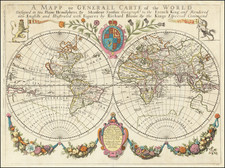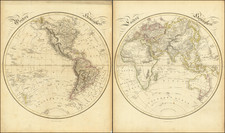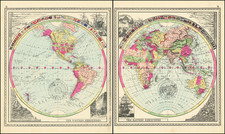A Rare Set of Ethnographic Images
Fascinating set of Ethnographic Images of various peoples of the world.
These striking pedagogical prints with ethnological subjects, including Australian Aborigines, a Maori, a Hawaiian, a tattooed Marquesan and a Papuan, were designed by the Anglo-German geographer Ernst Ravenstein. They exemplify the mid-nineteenth century European obsession with the taxonomy of racial types.
Includes peoples from all four continents, including:
- Oceanic Group
- American Group
- European Group
- Monosyllabic Group
- Turanians
- Caucasians
- Persians
- Indian
- African
Of note, the Hungarian is placed in the Turanian Group.
Turanism
Turanism or Pan-Turanianism is a nationalist cultural and political movement born in the 19th century, to counter the effects of pan-nationalist ideologies like Pan-Germanism and Pan-Slavism. It proclaimed the need for close cooperation or alliance between culturally, linguistically or ethnically related peoples of Inner Asian origin from Turkic peoples.
This political ideology originated in the work of the Finnish nationalist and linguist Matthias Alexander Castrén, who championed the ideology of Pan-Turanism - the belief in the racial unity and future greatness of the Ural-Altaic peoples. Castrén concluded that the Finns originated in Central Asia (in the Altai Mountains), and far from being a small, isolated people, they were part of a larger polity that included such peoples as the Magyars, Turks, Mongols, etc. It implies not merely the unity of all Turkic peoples (as in Pan-Turkism), but also the alliance of a wider Turanid race, also known as the controversial Uralo-Altaic race, believed to include all peoples speaking "Turanian languages".
Like the term Aryan, Turanian is used chiefly as a linguistic term, equivalent to Ural-Altaic linguistic group. Although Turanism is a political movement for the union of all Uralo-Altaic peoples, there are different opinions about inclusiveness. In the opinion of the famous Turanist Ziya Gökalp, Turanism is for Turkic peoples only, as the other Turanian peoples (Finns, Hungarians, Japanese) are too different culturally. So he narrowed Turanism into Pan-Turkism. The idea of the necessity of "Turanian brotherhood/collaboration" was borrowed from the "Slavic brotherhood/collaboration" idea of Panslavism.
According to the description given by Lothrop Stoddard at the time of first world war:
Right across northern Europe and Asia, from the Baltic to the Pacific and from the Mediterranean to the Arctic Ocean, there stretches a vast band of peoples to whom ethnologists have assigned the name of "Uralo-Altaic race", but who are more generally termed "Turanians". This group embraces the most widely scattered folk-the Ottoman Turks of Constantinople and Anatolia, the Turcomans of Central Asia and Persia, the Tatars of South Russia and Transcaucasia, the Magyars of Hungary, the Finns of Finland and the Baltic provinces, the aboriginal tribes of Siberia and even the distant Mongols and Manchus. Diverse though they are in culture, tradition, and even physical appearance, these peoples nevertheless possess certain well-marked traits in common. Their languages are all similar, and, what is of even more import, their physical and mental make-up displays undoubted affinities.
Rarity
The images are very rare. OCLC locates only a single example, in the American Museum of Natural History.











![[ Florida Natives ] Feriane, piscium, & reliquae annonae illatio. XXIII. [Bringing in game, fish, and other provisions]](https://storage.googleapis.com/raremaps/img/small/98703.jpg)
![(Mapseller Correspondence) [Rufus Blanchard Letter written to Charles Marseilles] (May 23, 1888)](https://storage.googleapis.com/raremaps/img/small/86063.jpg)


![[ British Religious Prophetess Joanna Southcott ] A Medical Inspection or Miracles will Never Cease](https://storage.googleapis.com/raremaps/img/small/87382.jpg)
